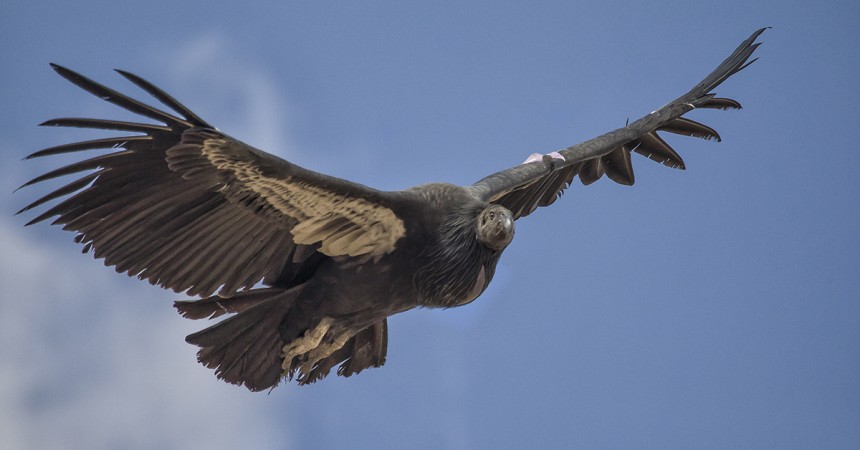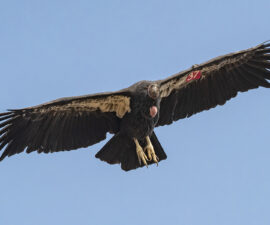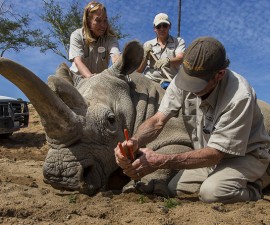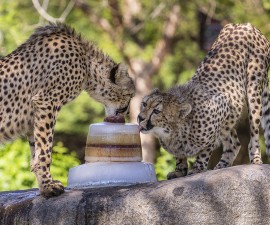Breeding season is underway at the San Diego Zoo Safari Park’s California Condor Breeding Facility!
In order to maximize success for the breeding pairs and their chicks, we try to conduct all of our maintenance work in the “off season,” which only lasts from mid-October to the beginning of December. We don’t want to cause any unnecessary disturbances during egg production, incubation, or chick-rearing. The chicks are usually moved from the parents’ pens by October and the new courtship season is in full swing by December, so during that short 1-1/2 month period we are busy with a multitude of tasks, preparing for the next season.
We made our yearly repairs to our breeding facility: replacing wood that may have been chewed by curious condors, securing perches, fixing leaky pool valves, repairing shift-pen doors, and adding visual barriers to better hide human activity to newly-fledged chicks that may be released to the wild someday. We also try to weed the majority of the flight pens, opening up area on the ground so the parents can forage for food and small bones in preparation for egg-laying. The trees and shrubs also get pruned so video camera access does not become obscured. Our pen and nest cameras also get serviced and cleaned. Lastly, and most importantly, the condors get their routine health exams.

In 2013, Condor Cam viewers were able to witness a condor chick hatching. What will we see in 2015? Stay tuned to Condor Cam!
Exams are conducted every two years. This year, 6 of our 28 condors were due for exams. During these exams, a number of procedures are completed. Our veterinary staff draws blood samples to test for any potential diseases that the birds may be carrying. A full body inspection is conducted, examining the tail, wings, feather condition, heart rate, respiration rate, eyes, ears, and mouth. If any wing tags need to be replaced, we do it at this time. A fecal sample is submitted to the lab to test for parasites. And finally, the birds are weighed before being released back into their flight pens.
We also changed the soiled substrate in the nests, so that when the next breeding season begins, the nests are clean. Normally, in the wild, a condor pair can have several nest sites within its breeding territory and they don’t always nest in the same cave every year. By changing nest sites, this allows the used nest to dry out and hopefully eliminate any nest hazards (insects, parasites, diseases, etc.) before the pair decides to nest in it again, preventing any potential health threats to a newly-hatched chick. Since we only have one nesting cavity in each condor pen at the Safari Park, we clean the nests every year: scrubbing and repainting the walls and changing the sand.
This year’s condor season is off to a slower start than usual. Every so often, based on genetic analysis, we receive new breeding recommendations from the California Condor Recovery Program. Of our seven breeding pairs, three are new pairings. It can take a while for the birds to settle in with their new mates, sometimes up to a year. So, we are not expecting eggs from those three pairs this year, but they could surprise us—you never know! One of our other pairs has a young female in it; only five years old. She is close to laying age, but, again, we are not expecting her to lay this season. Our other three pairs are experienced and have been together for a while.
Two of those pairs have laid so far. The first egg—from our well-known Condor Cam pair, male Sisquoc (pronounced “SISS-kwawk”) and female Shatash (pronounced “SHA-tawsh”)—was laid on 13 Feb 2015. It is doing well and is a potential candidate to hatch as the public watched the Cam this year around April 11. Frequent viewers may recall that Sisquoc and Shatash raised chicks on our livestreaming camera in 2012 and 2013. Their 2014 egg unfortunately failed to hatch, so they foster-reared another pair’s egg off camera.
Our second egg—from male Simerrye (pronounced “SIM-er-eye”) and female Ojja (pronounced “OH-jah”)—was also laid on 13 Feb 2015, fifteen minutes after Shatash’s egg! However, it failed to develop past Day 14 and died—an early embryonic death. Although disappointing, this can happen from time to time, just like with mammals. We removed the non-viable egg from the nest in an effort to persuade Ojja to recycle and lay another egg. For condors, it usually takes about 30 days for the female to recycle. If it’s not too late in Ojja’s season, she could lay another egg around April 5. Considering all of the recent activity at our breeding facility, and the number of new pairs, we are only expecting two to three more eggs for this season. Pleasant surprises are always welcome though!
We are not the only condor breeding facility experiencing a slower year. Our partners at the Los Angeles Zoo, the Oregon Zoo, and the World Center for Birds of Prey have some new pairings as well. Despite this year’s smaller batch of eggs, California condor production will still be good. Keep in mind that there are many wild nests already in progress at all five of the condor release sites in southern and central California, northern Arizona, and northern Baja California, Mexico.
Keep checking Condor Cam. We will soon be switching the camera view from our remote socialization pen to Sisquoc and Shatash’s nest as the due date of their egg approaches.
Ron Webb is a senior keeper at the San Diego Zoo Safari Park. Read his previous post, Condors: Feeding Time Manners.





